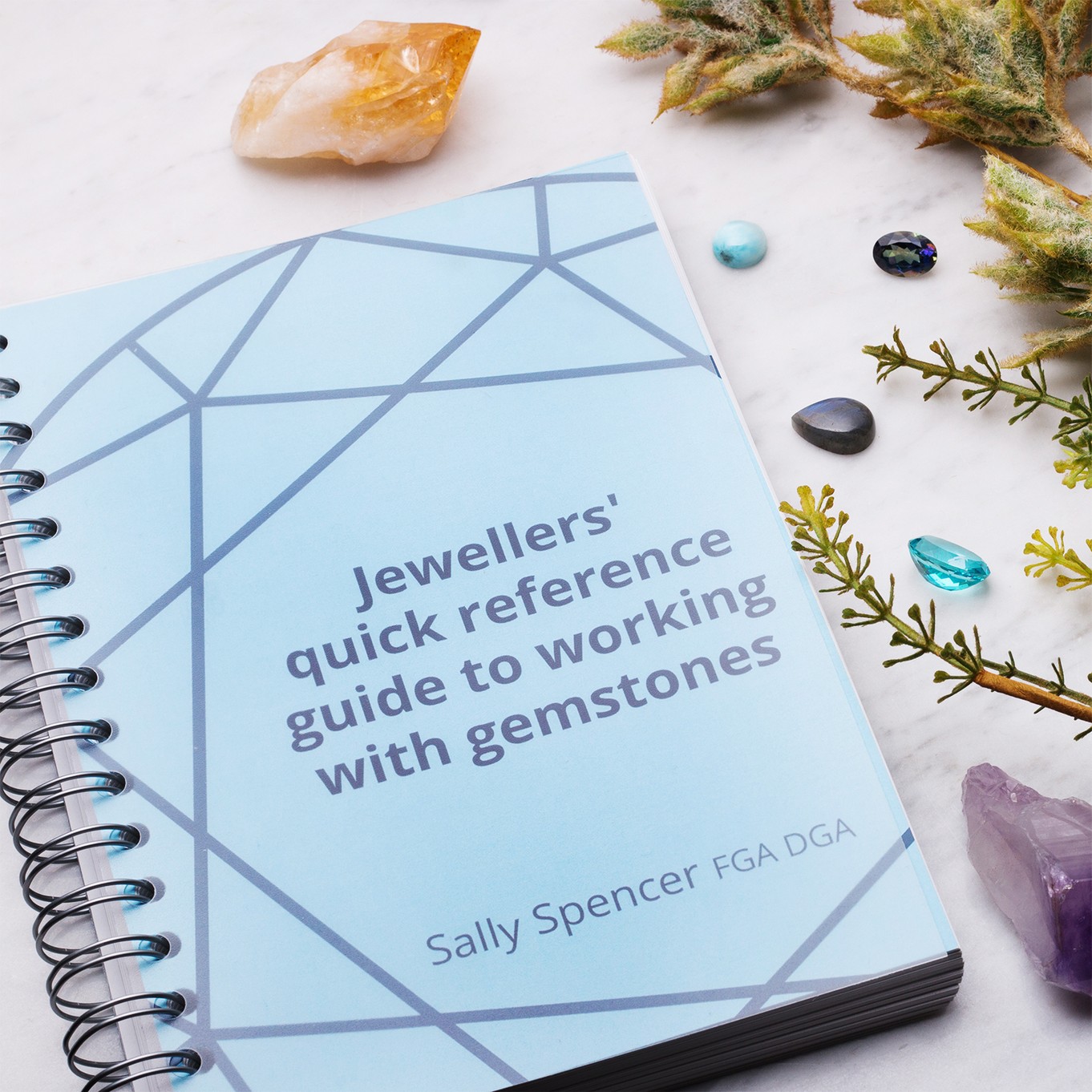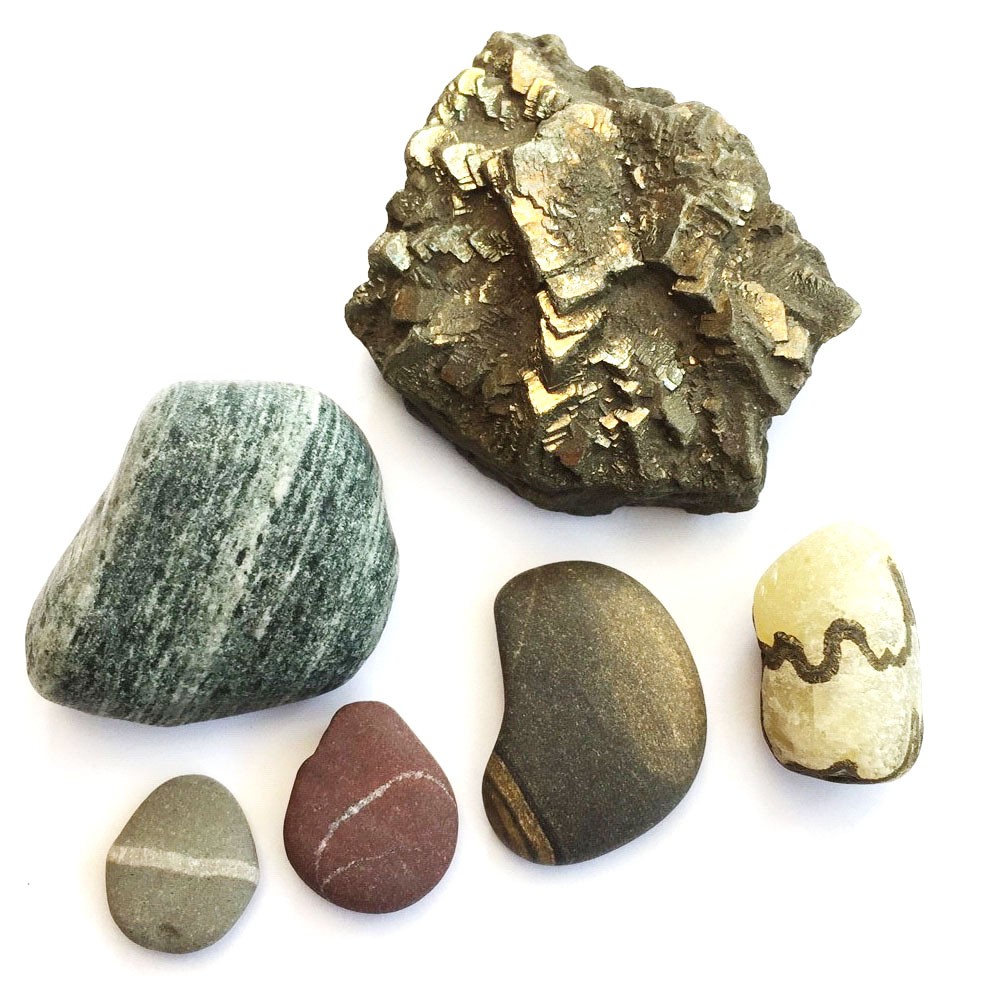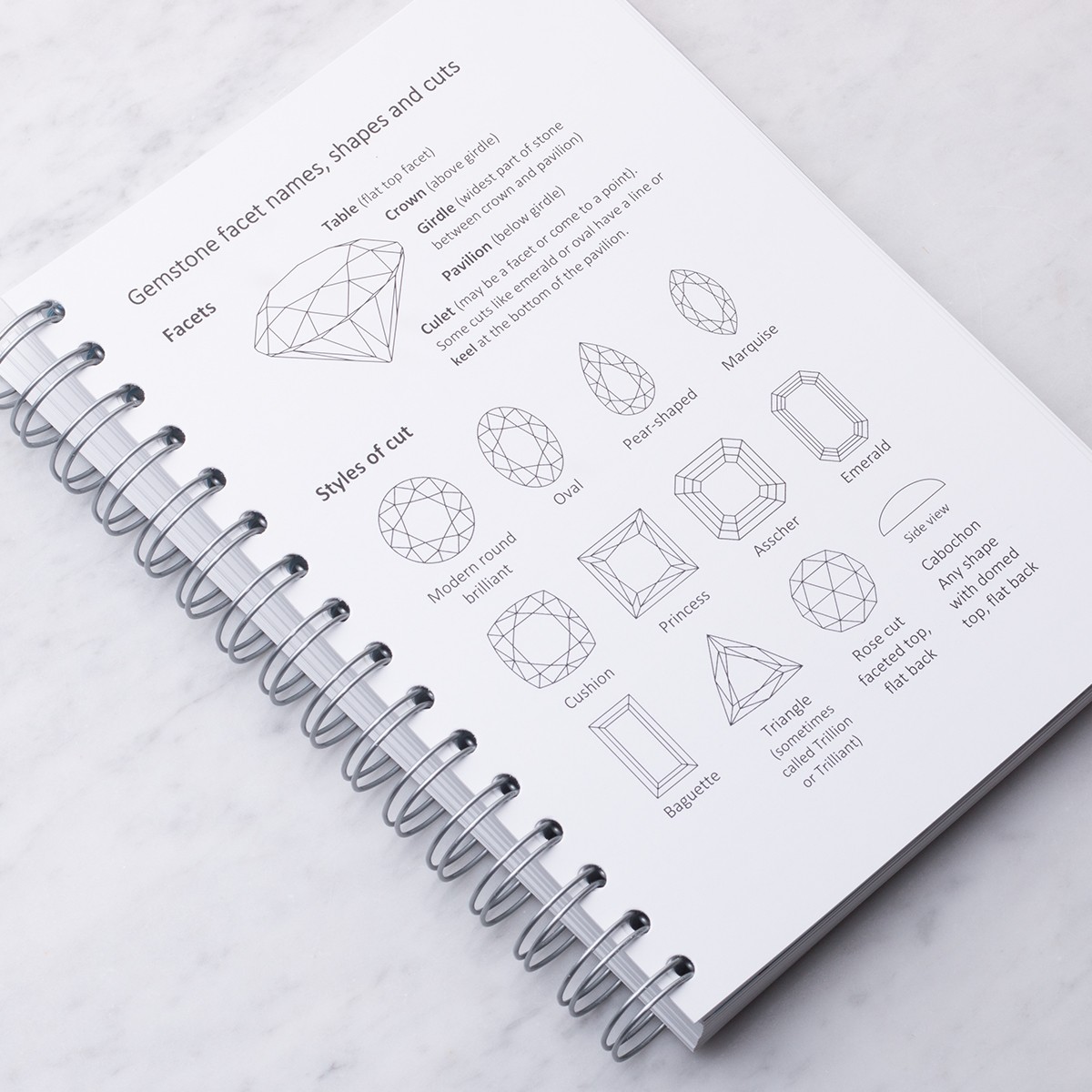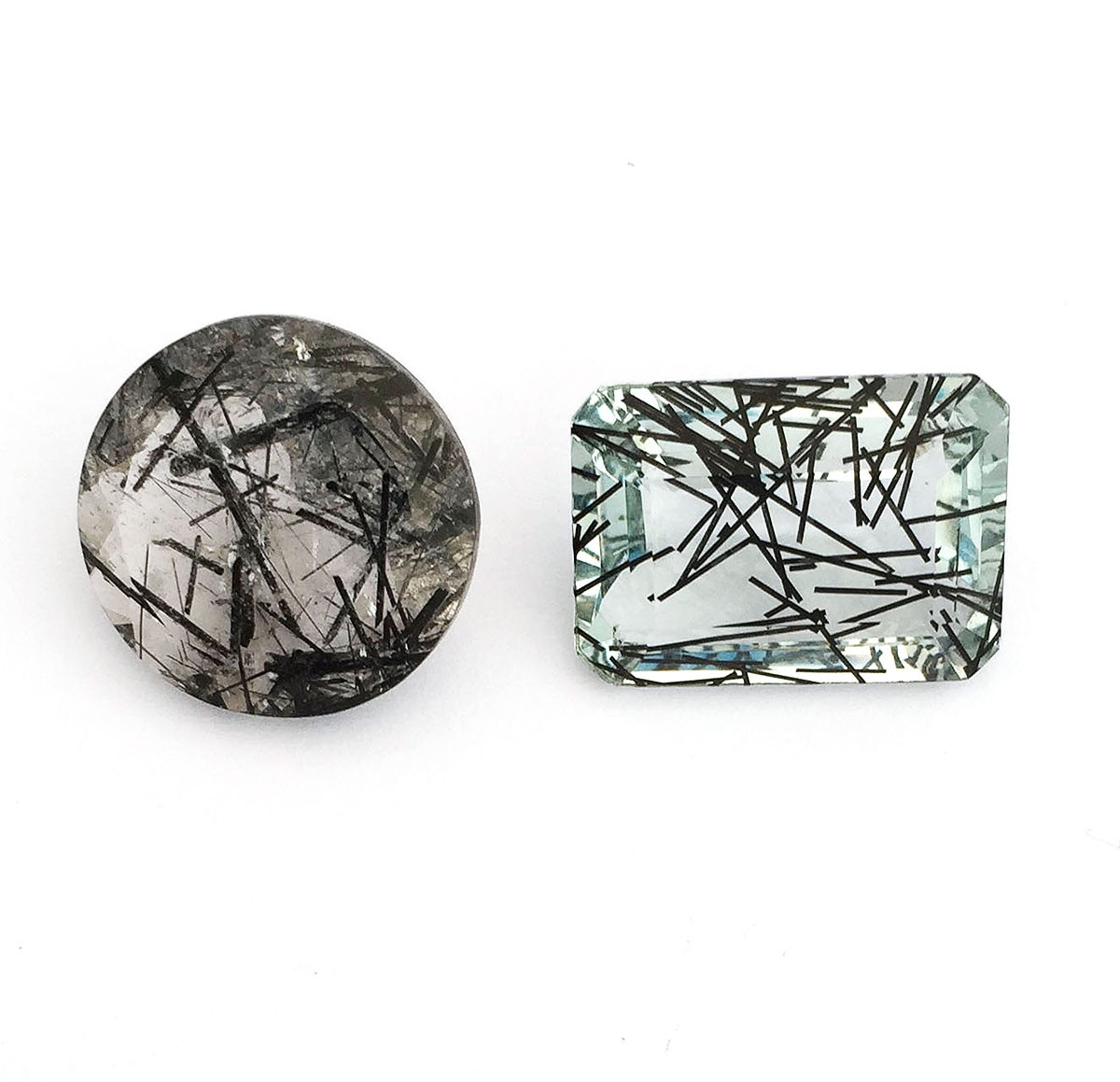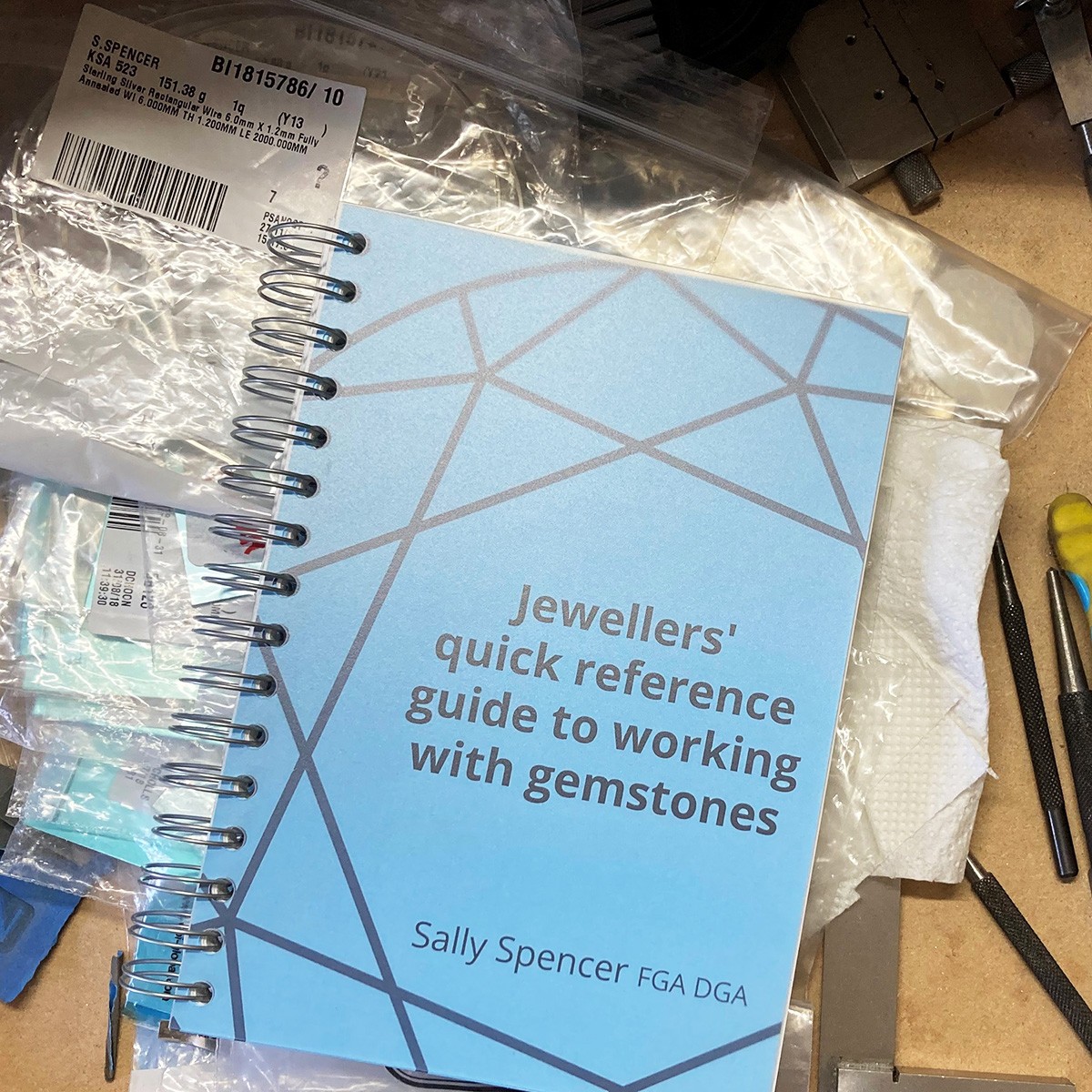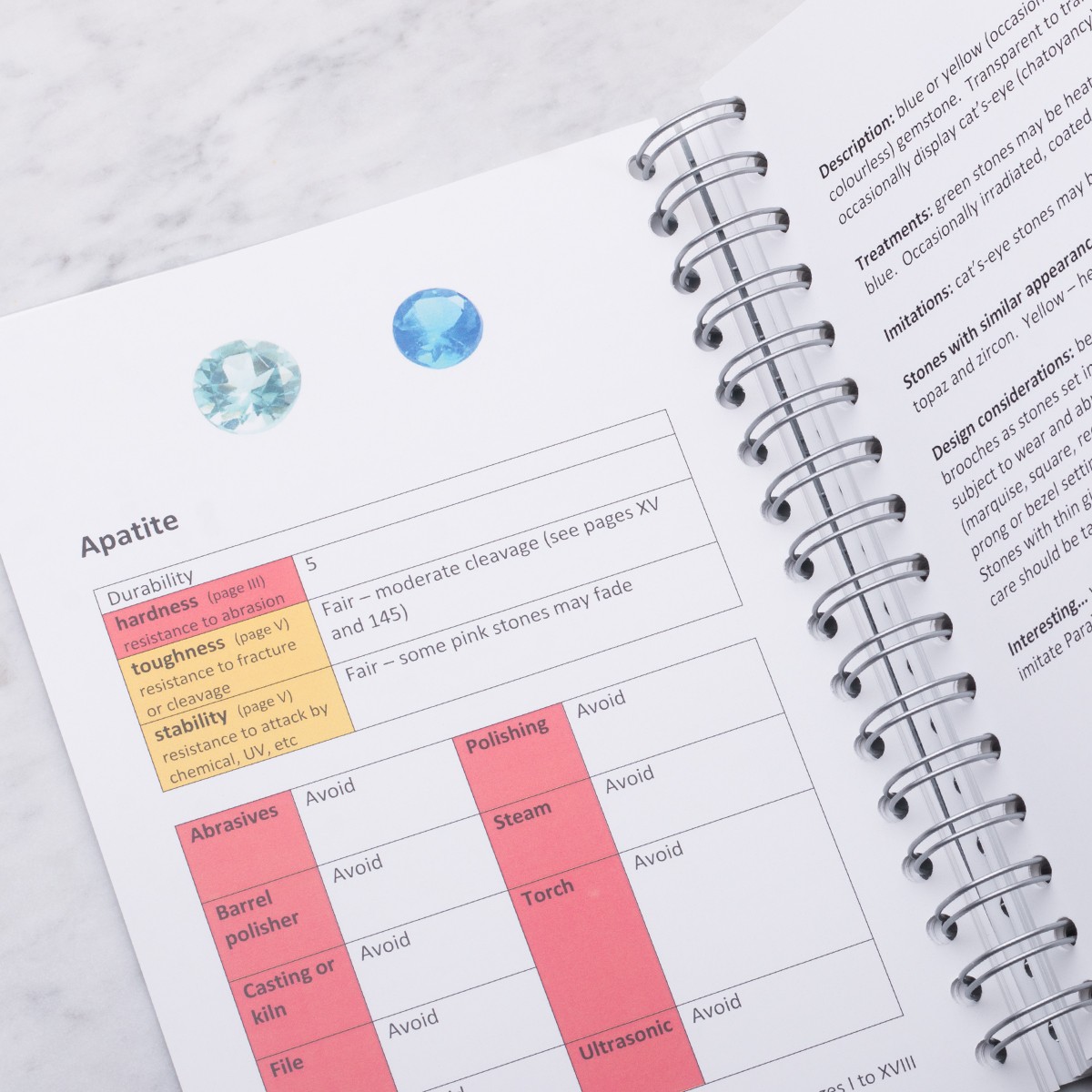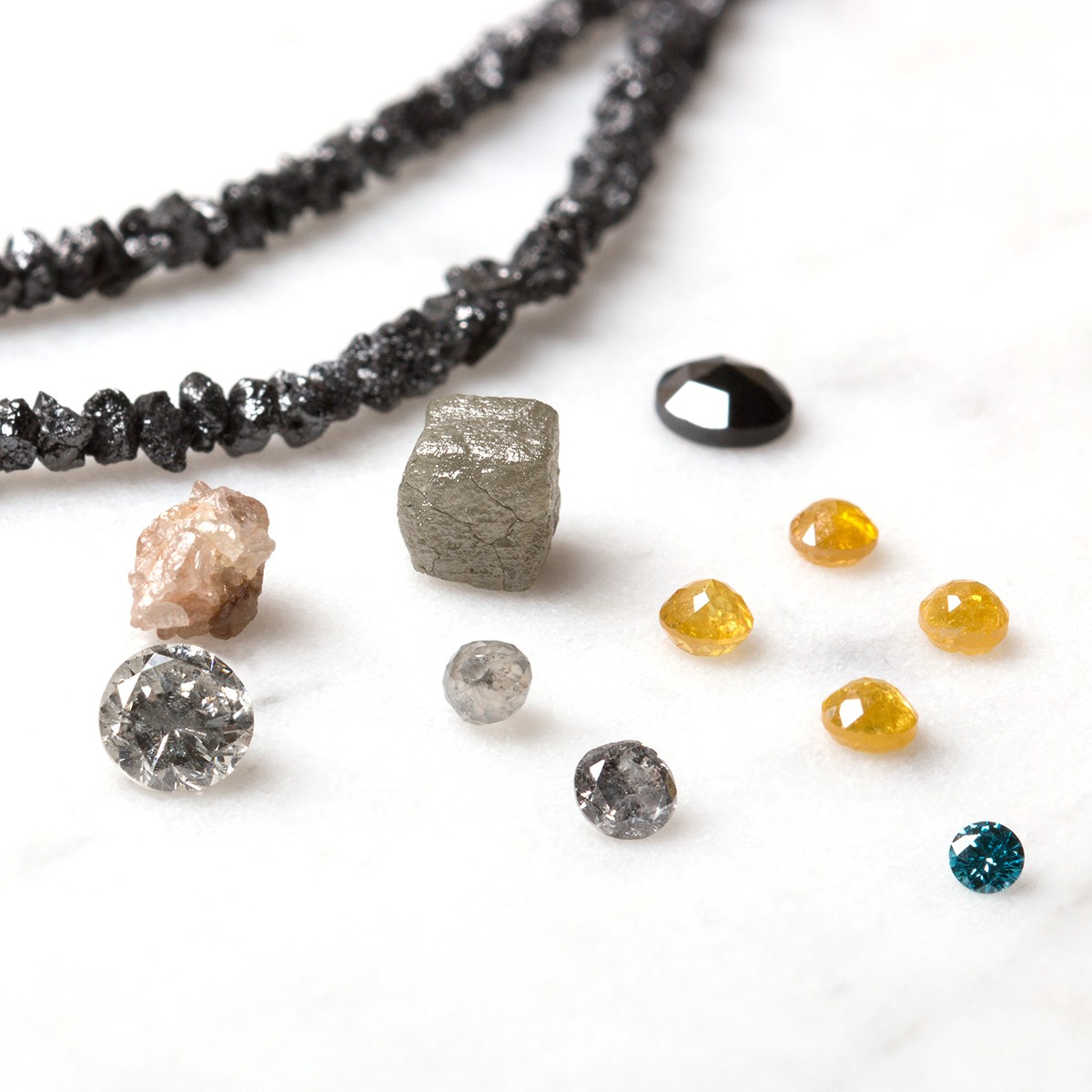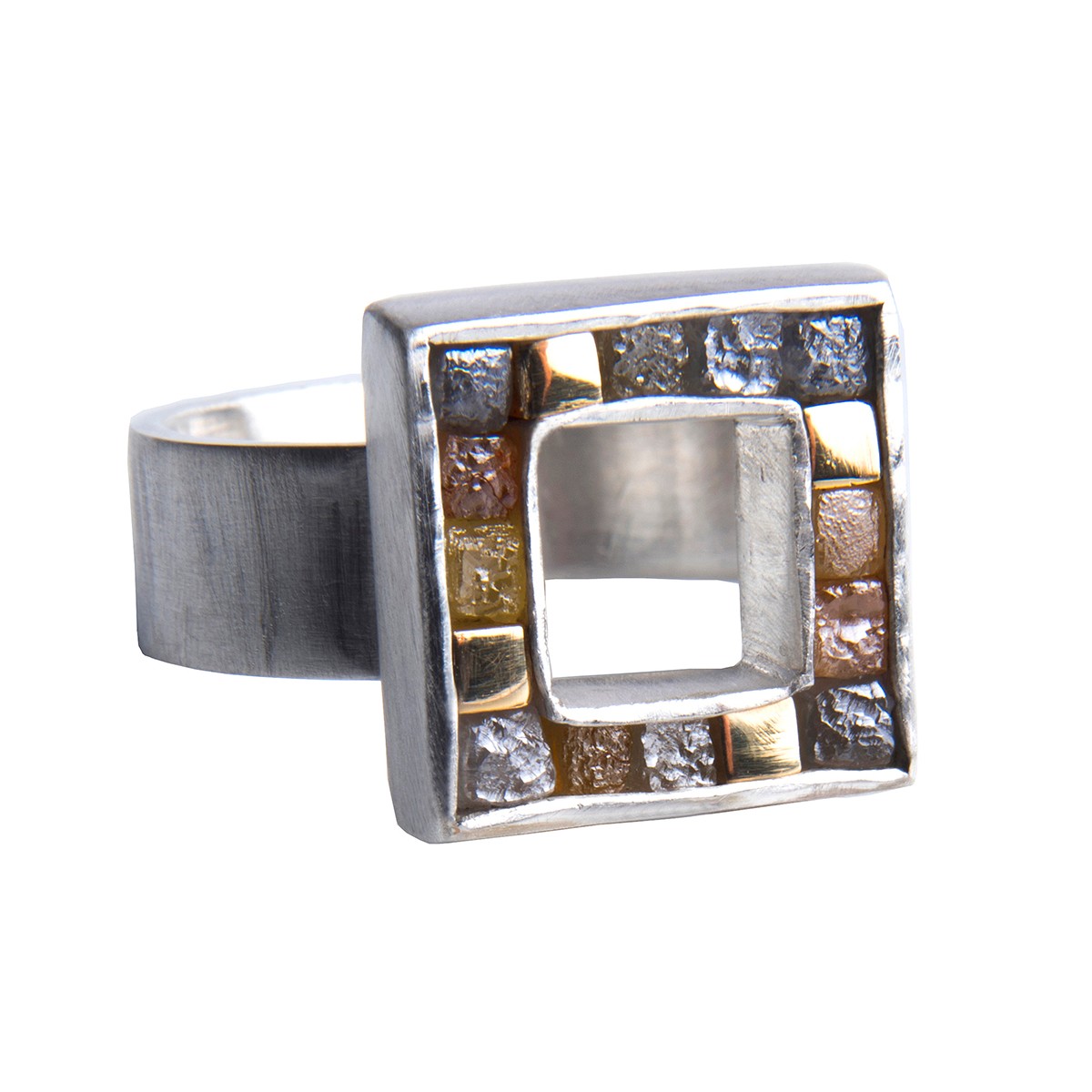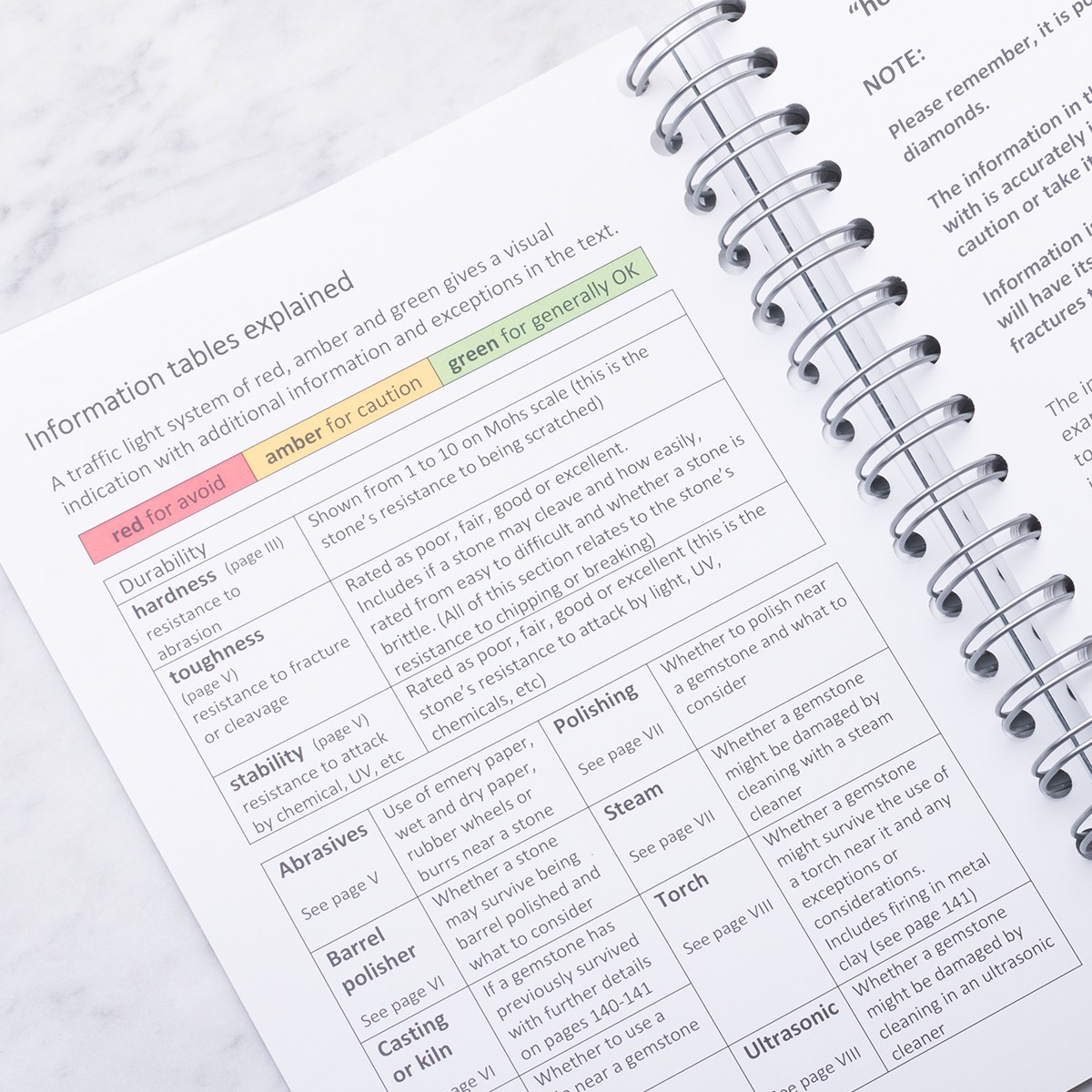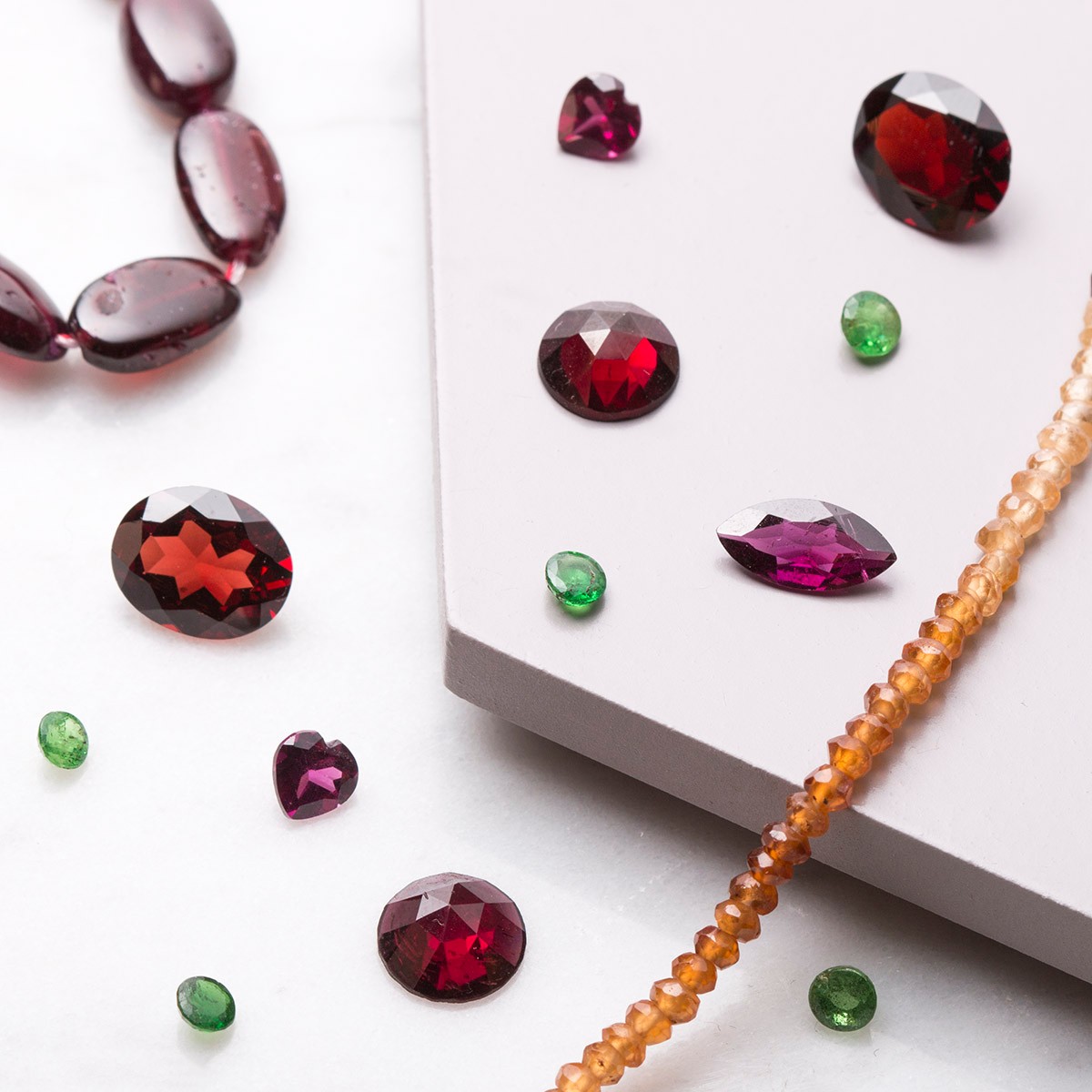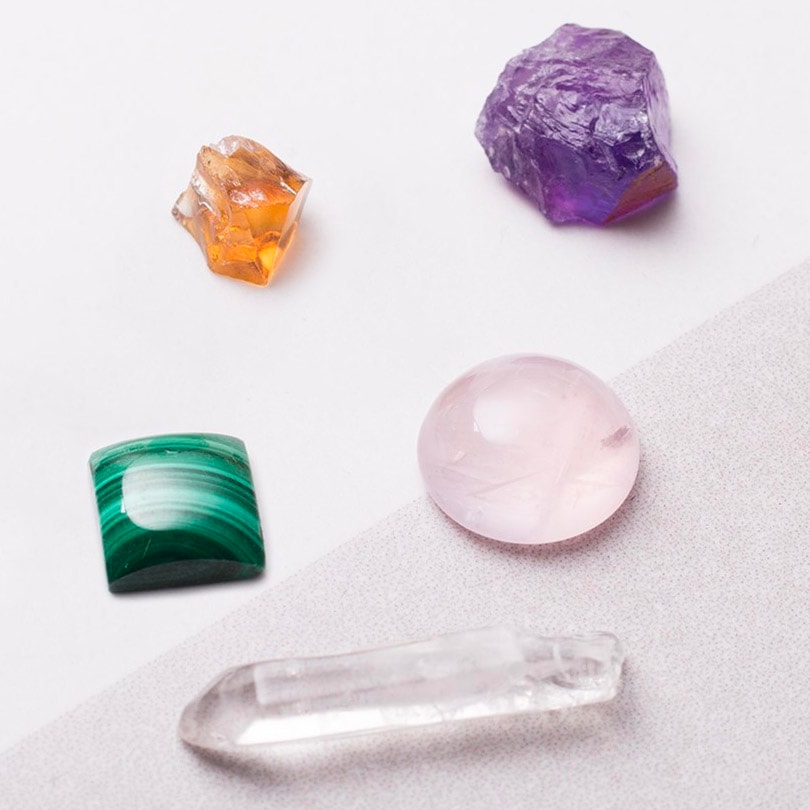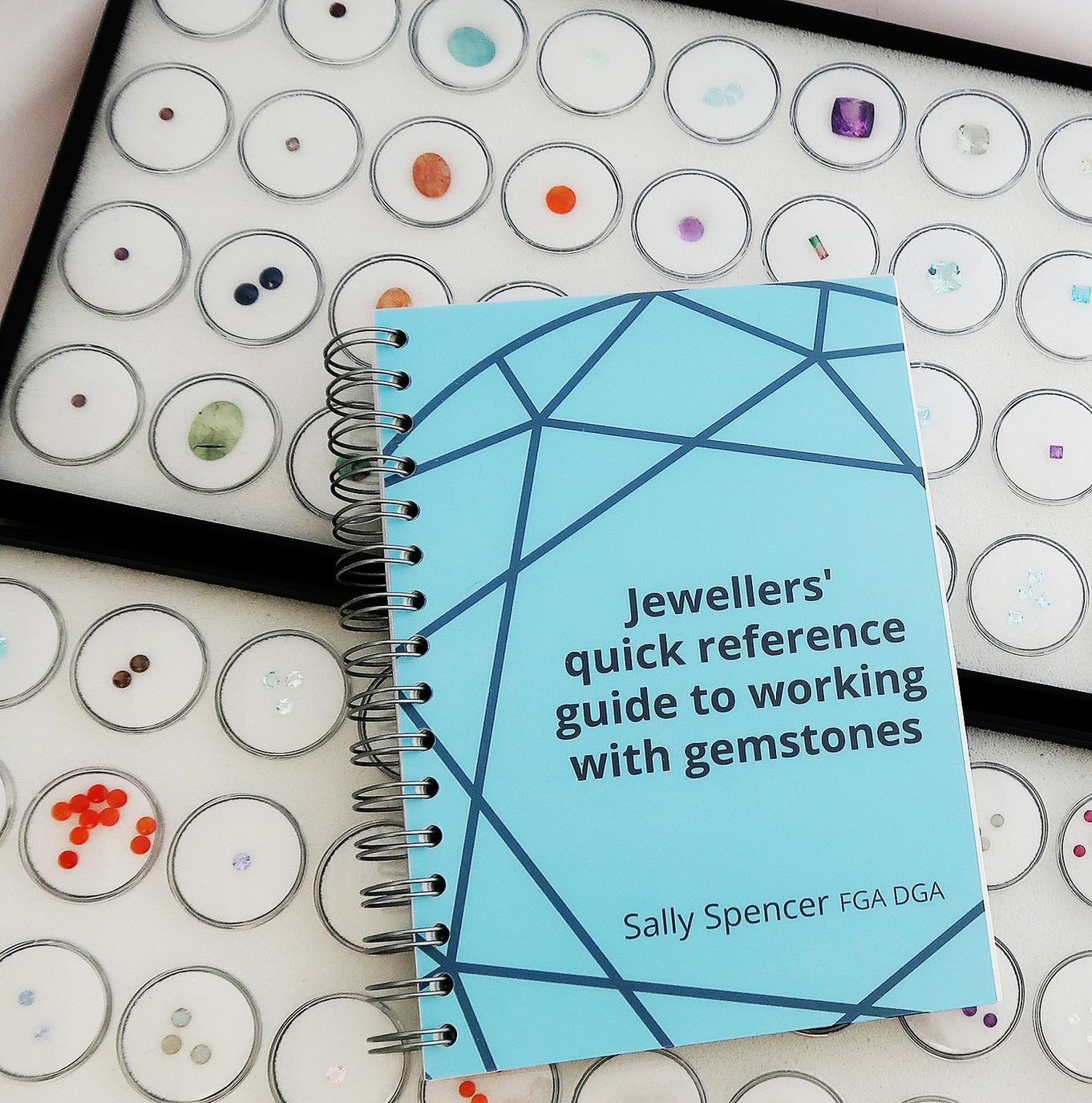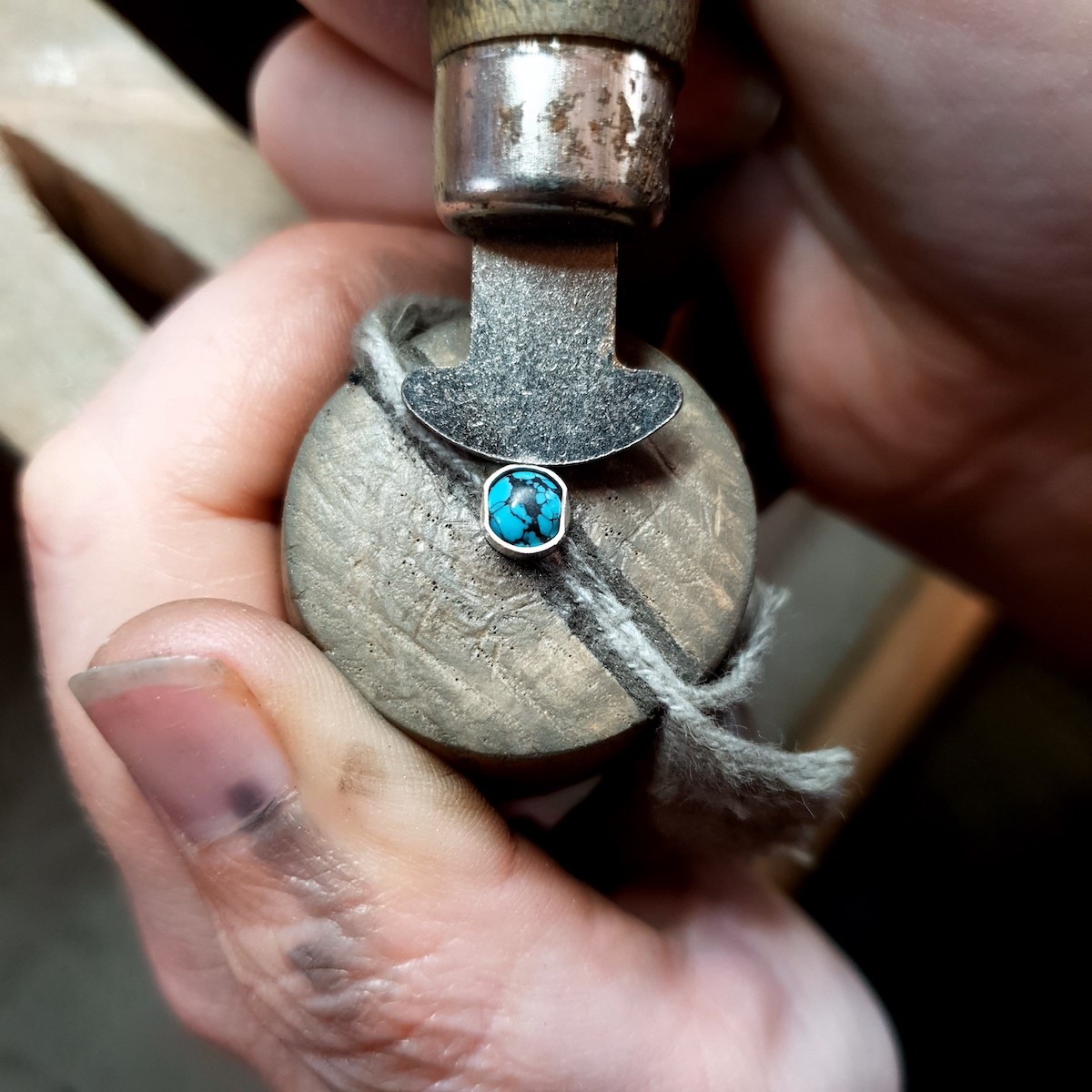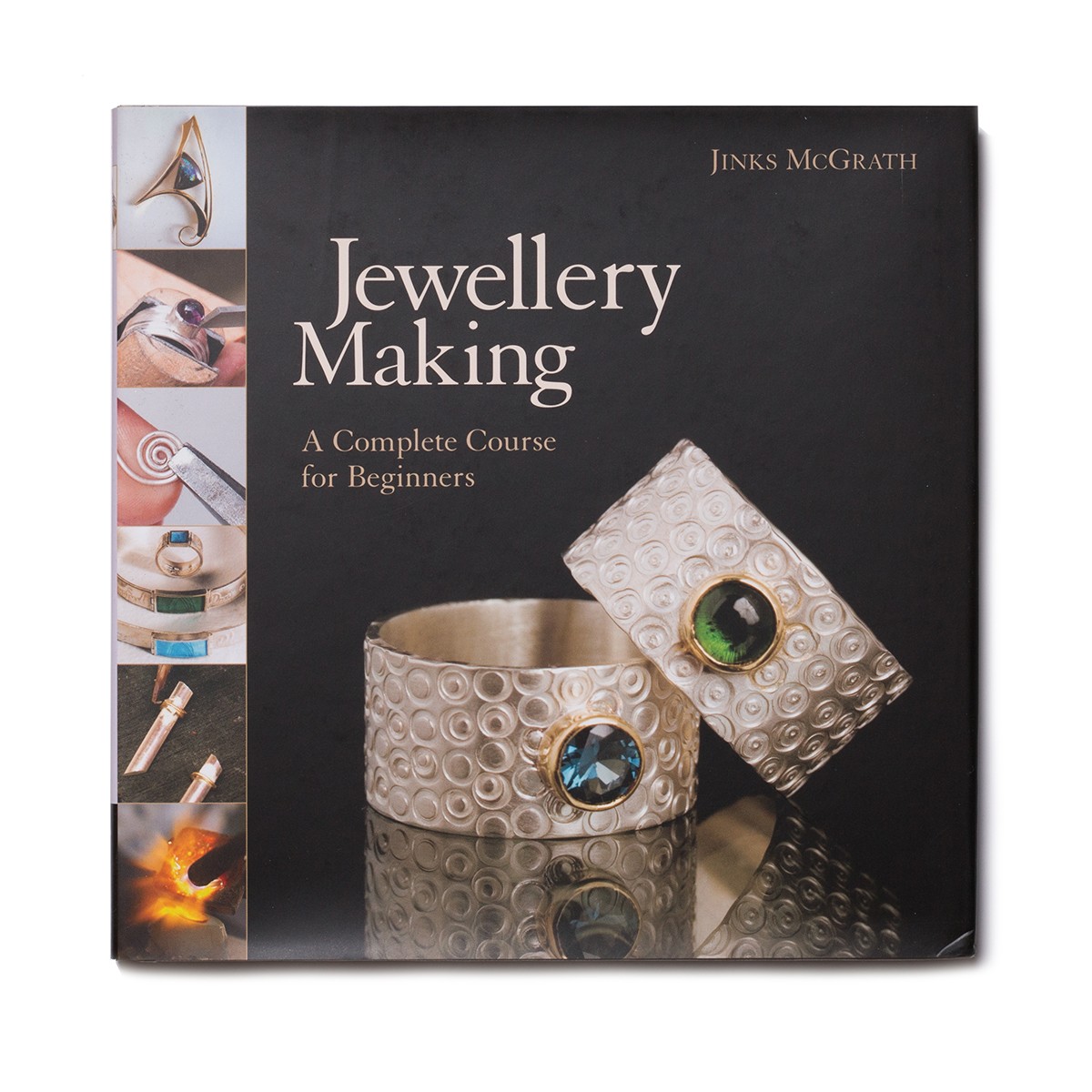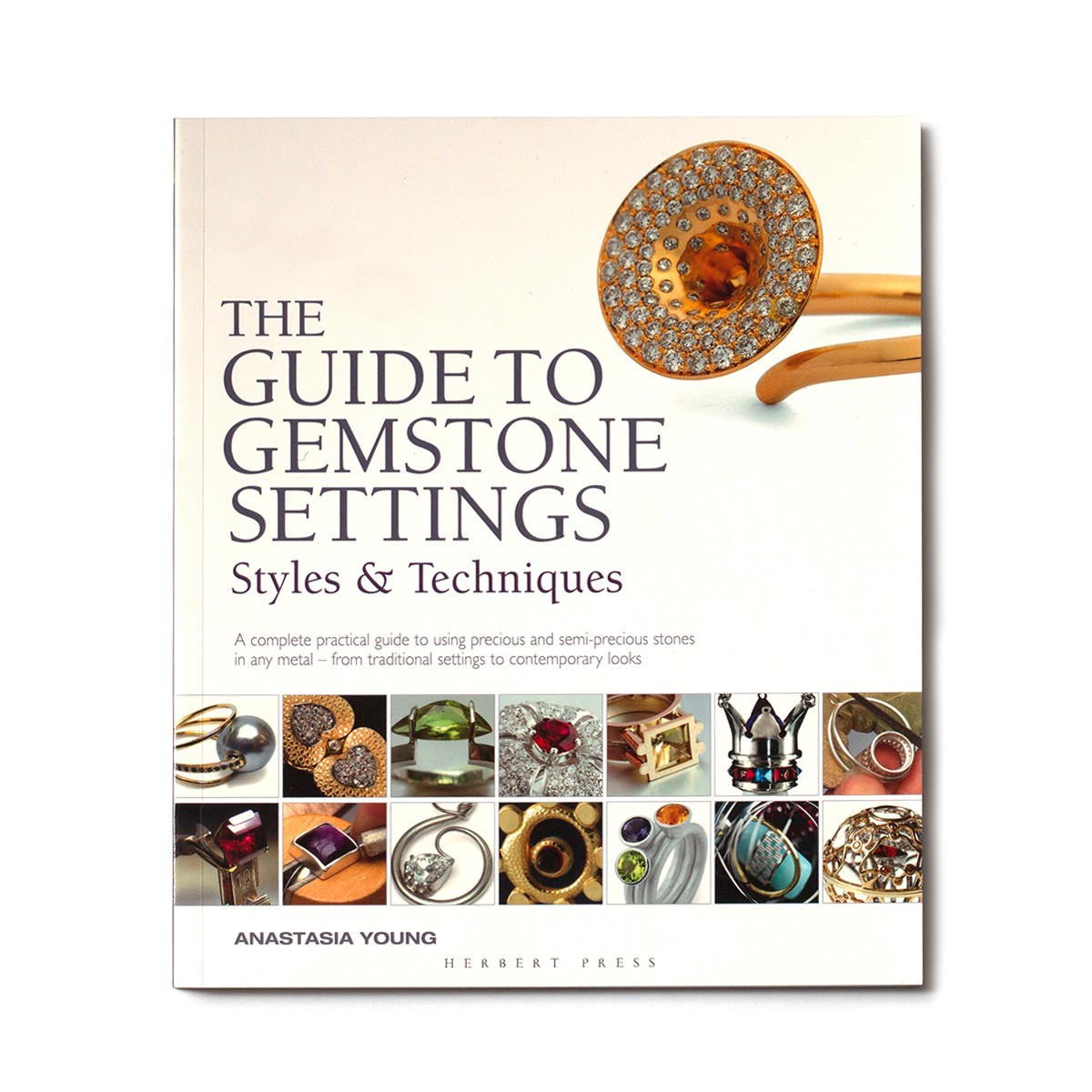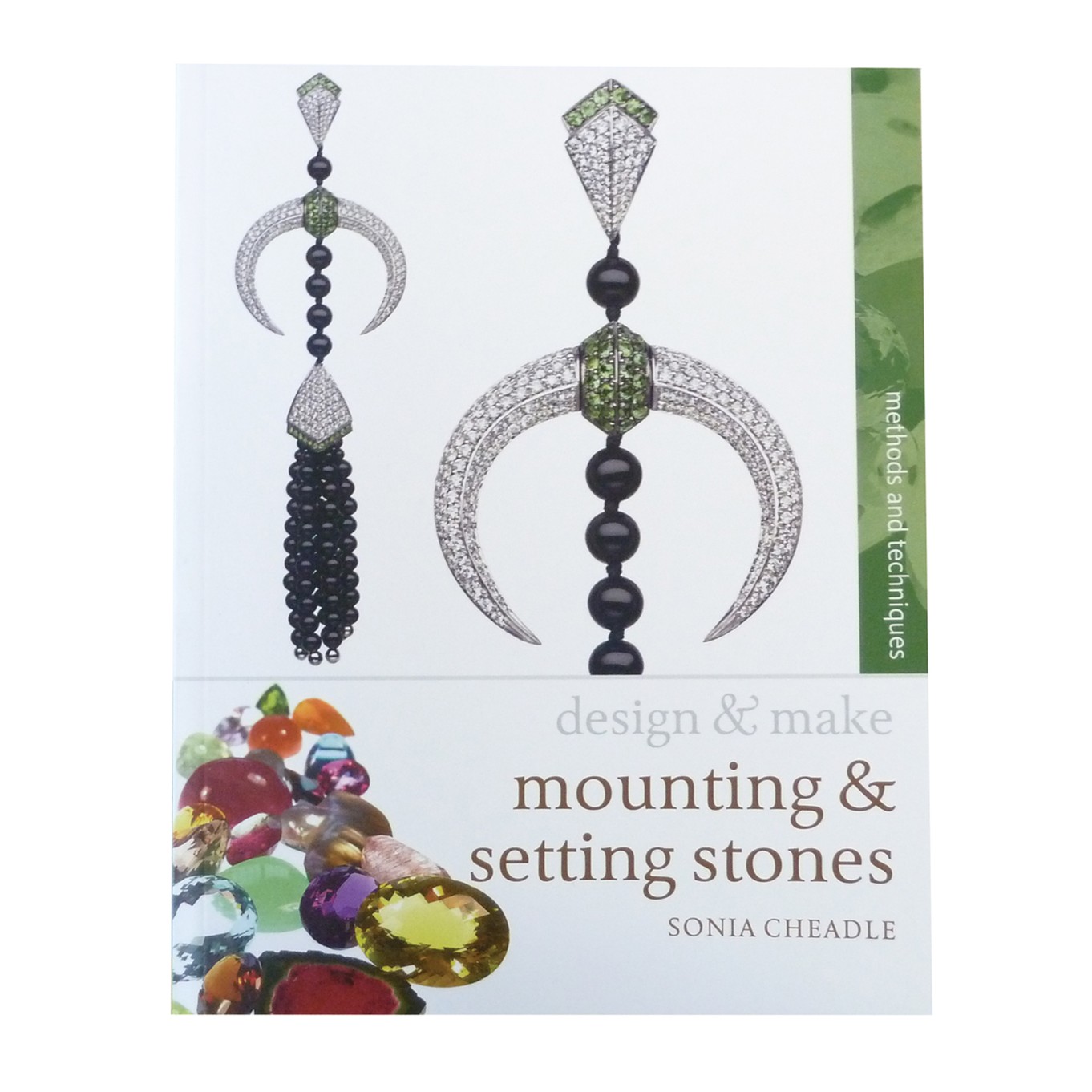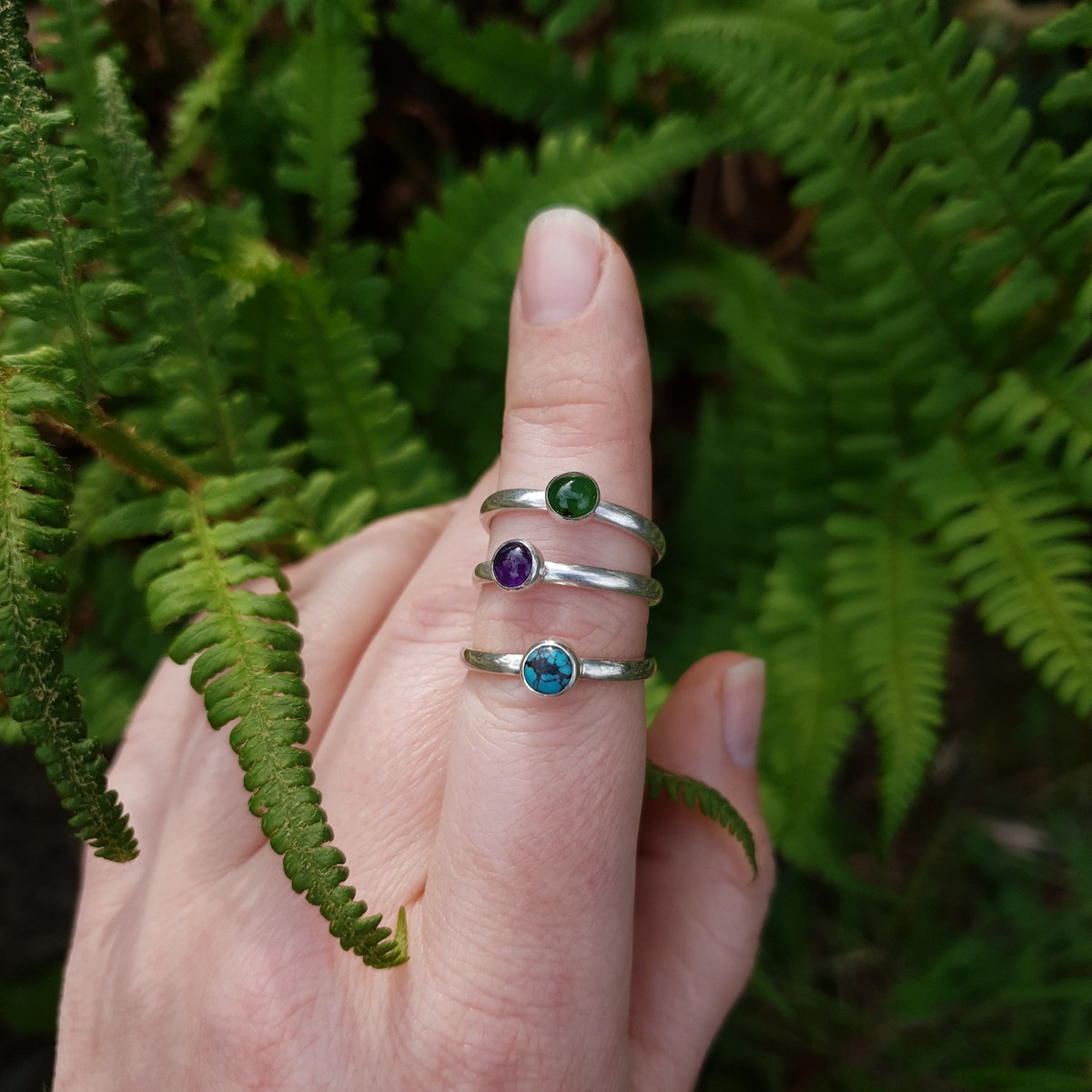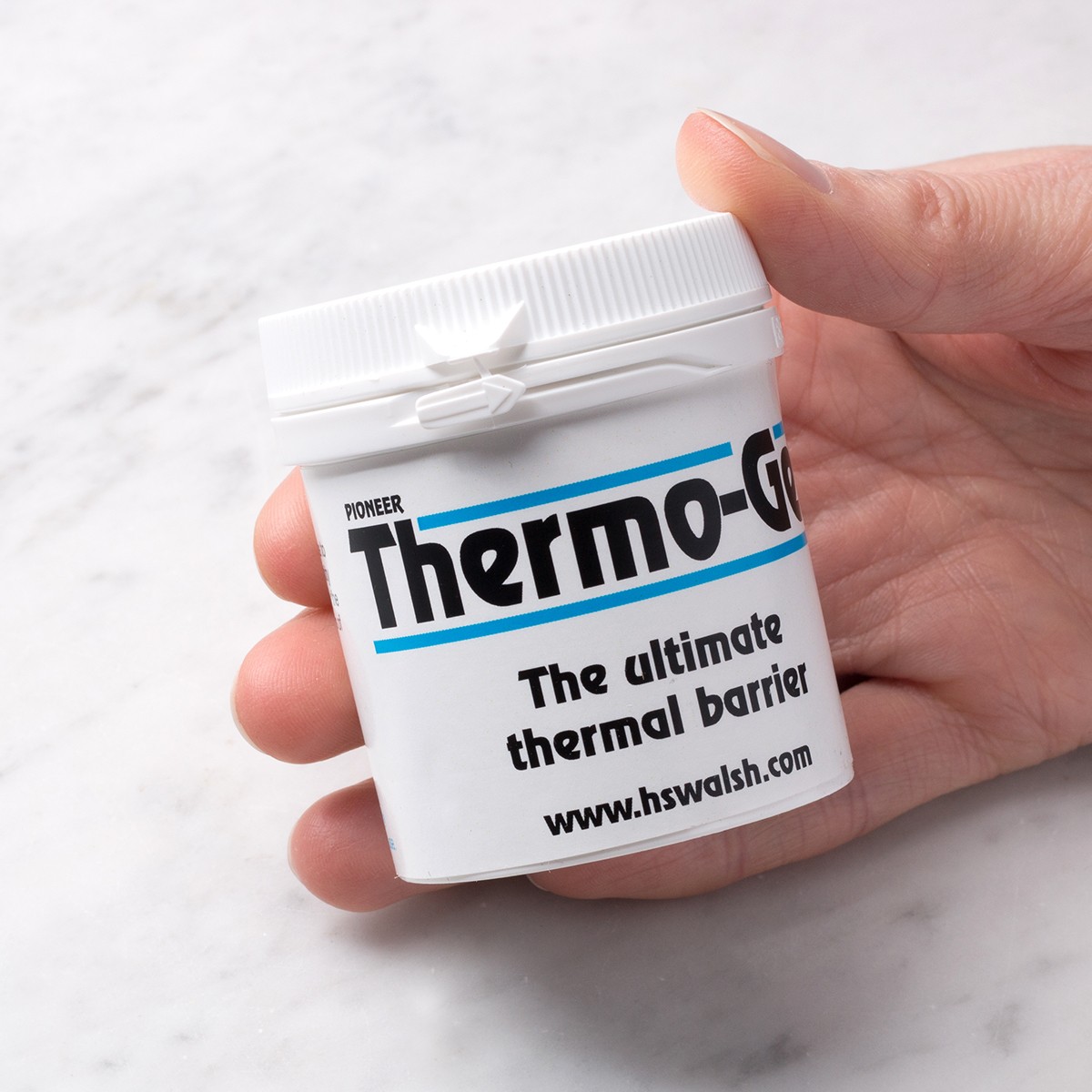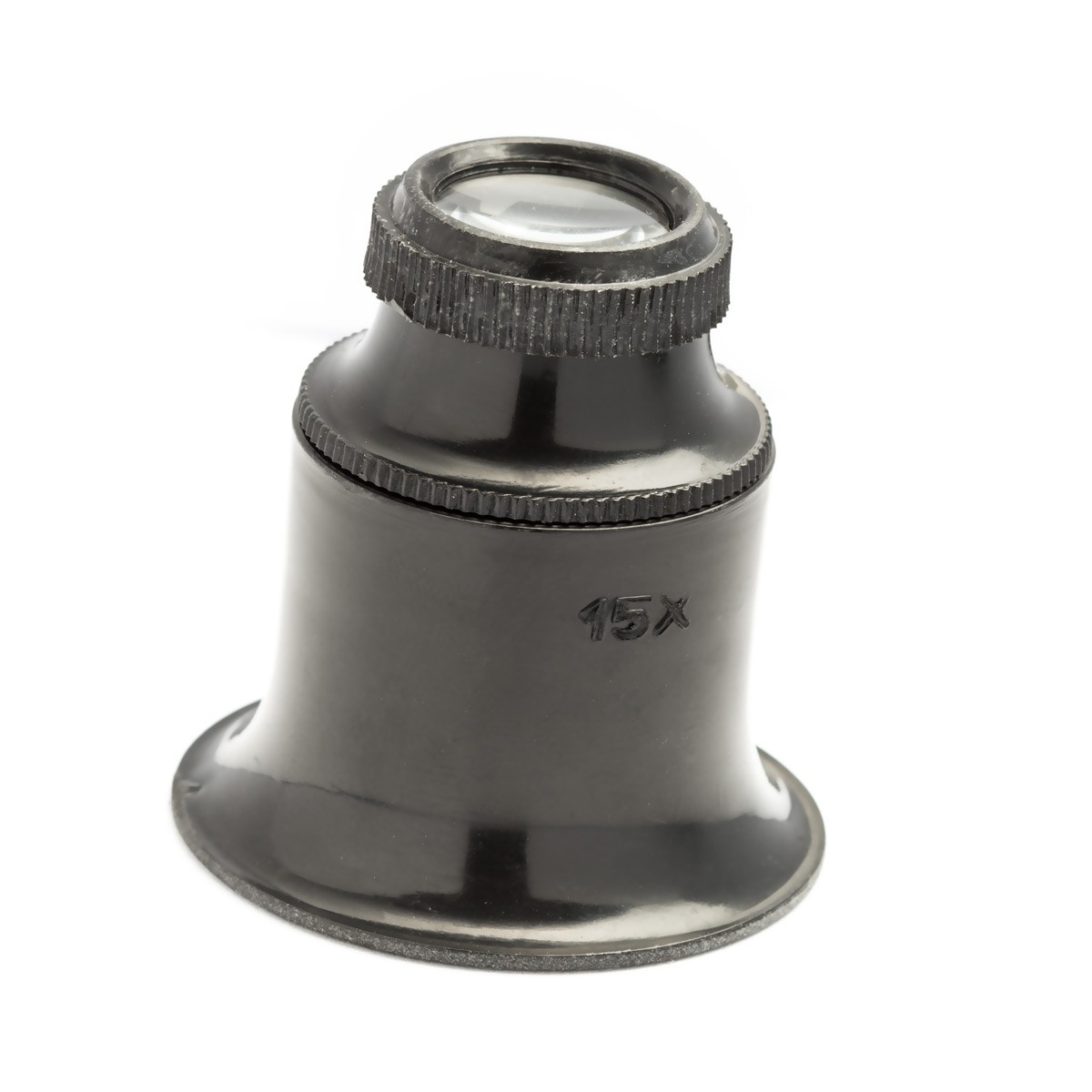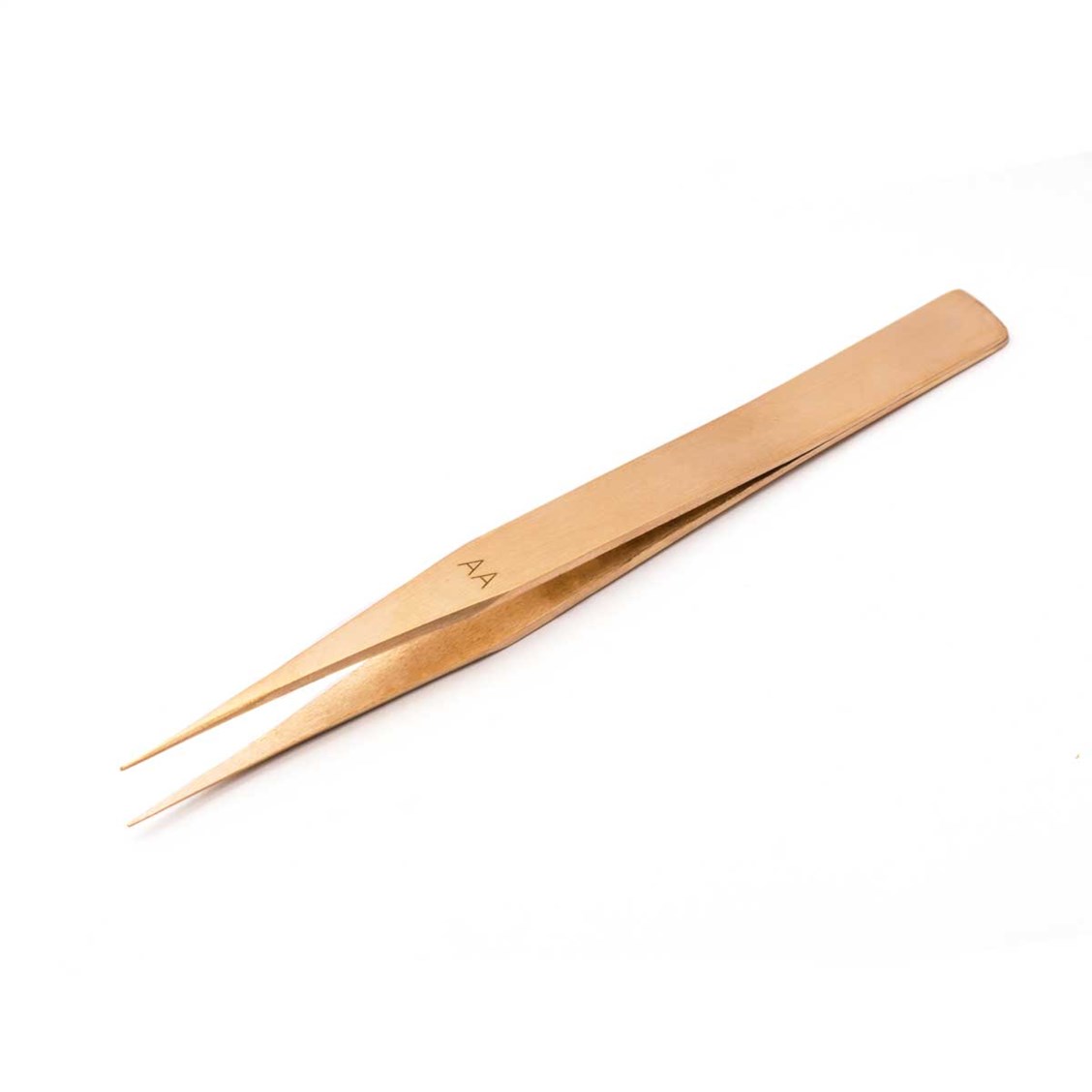How To Work With Gemstones As A Jeweller With Gemmologist Sally Spencer
We love a new book here at Kernowcraft and once we heard about Sally Spencer's latest release, we had to get our hands on it! On this page, we chat to Gemmologist, jeweller and now author Sally all about her book and how it can help you when designing a piece of jewellery. It's also a brilliant reference guide to use while working at the bench ready to answer any of your questions about working with gemstones. We learn more about gemmology and how it can help you in your jewellery making journey, as well as providing all the information you need to prevent you from accidentally damaging your gemstones - don't worry, we've all been there! We also share a video, giving you a sneak peek inside which is filled with helpful guidance and information tables.
Don't forget to grab your copy of Jewellers' Quick Reference Guide To Working With Gemstones as well as browse our full range of books online with Kernowcraft.
Look Inside Sally's New Book, Available To Purchase At Kernowcraft
"I wanted to write a book for jewellers that included a little gemmological information which could help them to avoid accidentally damaging gemstones..."
Hi Sally! We're super excited about your new book, Jewellers' quick reference guide to working with gemstones - tell us more about this and what we can expect
Hello! Ahhh, thank you! I wanted to write a book for jewellers that included a little gemmological information which could help them to avoid accidentally damaging gemstones. There is a section about how to use a loupe and tweezers to look at gemstones and photographs of visual clues that could give an indication of how a gemstone may react to the different jewellery making processes.
There is a “How to use” section which also gives some generic information about stones and various jewellery making processes including abrasives, barrel polishing, casting in place, firing in a kiln, filing, pickling, polishing, steam cleaning, heat from a torch (including firing in metal clay) and ultrasonic cleaning.
Each stone then has a two-page spread with example photo/s and a traffic light colour-coded table. This includes its durability (hardness or resistance to abrasion, toughness or resistance to fracture and stability or resistance to being attacked by chemicals, UV, etc) and which of the jewellery making processes detailed above it may or may not survive and why. On the opposite page is a description of the stone, details of any treatments, synthetics or imitations and any stones which may have a similar appearance.
"I decided to add some structure to learning about gems by studying with the Gemmological Association of Great Britain..."
Tell us about yourself and your background in gemmology!
Well, I am a self-confessed gem addict who loves jewellery and is partial to walking by the sea, doing a spot of fossil hunting or looking for shells or sea glass.
My love affair with stones started when I was small, spending many happy hours collecting pebbles on the beach. The stones may have become more expensive over the years, but I’m still fascinated by them and still love looking for unusual pebbles on the beach!
I decided to add some structure to learning about gems by studying with the Gemmological Association of Great Britain, completing both their Gemmology and Diamond diplomas and then becoming a Fellow of the Association. The exams were tough but having the opportunity to spend a week in a dark basement in London, surrounded by diamonds, was pretty special!
Using the additional knowledge in my jewellery making and sharing it through my teaching since then has been great and I continue to study gemstones and add to my teaching kit (any excuse to buy more stones…).
What exactly is gemmology and what does a gemmologist do?
Gemmology is the study of gem materials from their origins through to their use in jewellery - this includes their formation (within the Earth, laboratory, factory or farm), their mining or manufacture, treatments carried out on gemstones, their cutting and polishing and their use in jewellery, including its design. It’s a vast subject and there will always be more for me to discover and learn.
A Gemmologist uses their knowledge of the individual characteristics of different gemstones to identify them and to determine whether they are natural, synthetic or treated.
There are around 200 gem species, each of which may have several different varieties. For example, Beryl is a species of gemstone which includes the varieties emerald, aquamarine, heliodor, morganite and goshenite. As you can see, this multiplies up to a considerable number of different natural gemstones!
I think the most important thing I have learnt over the years is that the more you know about gemstones the more you realise you don’t know…
"My hope is that they will sit on or next to jewellers’ benches, ready to answer that “should I be doing this” question as it pops up or offer some guidance during the design process..."
What resources do you use to continue learning about gemstones?
There are many gemmological reference books, copies of which are still making their way into my collection. While the information on treatments and synthetic stones may be out of date in the older books, there is still a lot of useful information to be found on the basics of the gemstones themselves. I also find it fascinating to look back and see how treatments have evolved and how far the growing of synthetic gemstones has come.
Gemmological journals are regularly produced, bringing together the latest discoveries, reports from gem testing laboratories and research papers. Equally, some of the Gemmological Associations, Institutions and Laboratories regularly publish new information on their websites.
During lockdown, a number of gemmologists gave webinars about their area of expertise which was amazing. It was a wonderful way to feel connected to the outside world at that time and a privilege to learn from some of the academics you would never usually have the opportunity to see in person. One of the opal experts in Australia got up in the middle of the night to give a webinar presentation which was so generous!
"I’m also hoping that by including some of the more unusual gemstones in the book, jewellers will feel more confident in using those in their designs and enjoy introducing them to a wider audience..."
What was your inspiration behind writing your book?
As a Gemmologist I don't like to see damaged or broken gemstones and as a jeweller I understand how frustrating it can be when that happens, especially when it might be avoided with a little additional gemmological knowledge. There are many beautiful books about gemstones available but while teaching my jewellery classes and answering my students’ gemstone queries, I realised there were none that could sit on the bench and be quickly referred to while you are working.
Is the book one you'd recommend keeping at the bench for future reference?
Absolutely! It was designed to be a little work horse with thick glossy pages, plastic covers for protection and it’s wire bound so that it can lay open on the bench. My hope is that they will sit on or next to jewellers’ benches, ready to answer that “should I be doing this” question as it pops up or offer some guidance during the design process.
What would you like jewellers to take from the book?
I am hoping that, while using the book, jewellers will come to understand a little more about gemstones and the best ways to use them in their designs, working with their strengths and designing for their potential vulnerabilities.
I’m also hoping that by including some of the more unusual gemstones in the book, jewellers will feel more confident in using those in their designs and enjoy introducing them to a wider audience.
I also hope that it will help jewellers appreciate the importance of buying gems from reputable dealers so that they can be confident in knowing the correct identity of the stone they are buying. This is not just for when they are working with it but also so that they can provide the correct gem identification and disclose any treatments to their customers, giving both them and their customers greater confidence.
"Diamonds are attracted to grease… which is why you should take your diamond rings off before applying hand cream!.."
What's your favourite gemstone fact?
My favourite gem geek fact is that diamonds are attracted to grease… which is why you should take your diamond rings off before applying hand cream! This property was first exploited in the diamond mines of South Africa in 1896 when they passed a slurry of water, host rock and rough diamonds over tables coated in grease. The diamonds stuck to the grease which would be scraped off the tables at the end of the day, placed in a wire basket and dipped in hot water, melting the grease and leaving a basket of diamonds… Despite the use of x-ray machines during diamond processing today, grease tables are still used as well.
One that amuses me is that the astonishingly vibrant turquoise-blue gemstone Hemimorphite is a component of chalky-pink calamine lotion… Chemist and mineralogist James Smithson discovered in 1803 that the mineral Calamine was in fact two similar but different minerals, zinc carbonate (subsequently named Smithsonite in his honour) and zinc silicate (now named Hemimorphite). While the mineral name Calamine no longer exists, it is still listed as an ingredient in calamine lotion today.
Would you like to write another book in the future?
There is another book in the planning and research stage - funnily enough it’s about gemstones!
"Whatever stage you are at in your jewellery making journey, the most risk possibly comes when setting the stones..."
Why is gemmology so important when it comes to jewellery making?
Most jewellers who work with gemstones already have some gemmology knowledge, whether it is along the lines of knowing that amethyst is purple and not yellow or red, or knowing about the hardness of gemstones, making some stones more suitable for earrings while others will stand up to being worn every day in a ring.
Adding a little more knowledge to this by understanding more about a stone’s durability, how it may react to the jewellery making processes and any treatments it may have had could help jewellers avoid damaging stones. It could also help when designing jewellery, not just by considering whether a stone is suited for a particular piece of jewellery but also the best style of setting to protect a particular stone.
What are the main reasons for gemstones to be damaged during jewellery making?
Whatever stage you are at in your jewellery making journey, the most risk possibly comes when setting the stones. This could be through applying too much pressure to a setting and fracturing a stone, a setting tool slipping and chipping or scratching a stone or using an inappropriate method of tidying the setting by damaging the stone with abrasives, files or polishing.
Some information about the durability of gemstones and the composition of various abrasives and polishing compounds alongside considering the cut of the stone and the design of both the setting and piece of jewellery could help to avoid some of these problems.
"I love sharing my passion for gems and jewellery with others and have been teaching for around 15 years now..."
What's your favourite gemstone and why?
Well, that’s the million-dollar question… From an academic point of view, it would have to be diamonds (although I’m rather partial to the stones themselves too!). There is a great deal of fascinating documentation around the discovery of diamonds, their mining, famous stones and my favourite area which is the history of creating synthetic diamond – a hot topic which is still growing and evolving today.
From the point of view of one in my collection (sounds grand but it is a little box of unusual gems or gemmological curiosities) it would probably have to be a colour change garnet from Madagascar. Garnets themselves are a fascinating species of gemstone and I am in awe of the Anglo-Saxon goldsmiths who used garnets in their work, but when you add in the property where they appear different colours in different lights, that just makes them extra special. I keep promising myself that stone will become a ring for me, one day…
I know this choice will make it three, but they are favourites for different reasons and sapphire would be my favourite to wear in a piece of jewellery. Their durability makes them suitable for all types of jewellery and if you include ruby, the other member of the corundum family, they can be found in every colour as well as parti-colour or multicolour. You can also find star sapphires with their mesmerising asterism and colour change stones too – they just have something for everyone!
Then there is always a new, unusual gem that I’ve come across which appears on this list too but it’s just getting longer and longer so I’ll stop at three!
"As with all new things, only practise will improve a technique so don’t be too hard on yourself..."
You also teach gemmology workshops, tell us more about this!
I love sharing my passion for gems and jewellery with others and have been teaching for around 15 years now.
Introducing jewellers, antique dealers and those with a fascination for gems to the basics of gemmology and using it to help with identifying gems is great fun and I’m in the process of developing two new courses which will complement the book. One of these will be a live, online class, going through the gemmological information in the book as well as how to use a loupe and tweezers to study stones. The other will be an in-person one day course which will also allow students to learn more about the gemmological information as well as having the opportunity to see and study examples of the stones, including some of the treatments.
I love teaching and sharing gems so I can’t wait to get these underway!
Tell us about your experience of writing a book and the most challenging part!
I loved having the opportunity to completely immerse myself in gemstones and concentrate on finishing the book but sadly that came about because of the pandemic and being unable to work as usual.
As we were in lockdown, I couldn’t travel to source stones for some of the photographs, but Jon Mehdi of Gemgazer very kindly came to the rescue with the fantastic photographs illustrating inclusions and potential vulnerabilities in gemstones. I also couldn’t hire a photographer so had to climb a very steep learning curve of photographing gems – almost as challenging as photographing jewellery!
Pulling all the elements together, finishing the book and self-publishing during the various lockdowns was definitely a big challenge!
"Have fun with it, explore your own creativity - design and make jewellery that is unique to you and contains a little bit of you and your passion for your new craft..."
Do you have any top tips for jewellers at the start of their jewellery making journey?
Welcome to our wonderful world!
There are many tutorials and courses available on the internet but, if possible, I would suggest trying to find a class near you as well. Sometimes there is nothing like being shown a technique in person or being able to ask a question and have a teacher show you an alternative way that may better suit your way of working. There is usually more than one way to achieve a particular technique or outcome when making jewellery, it may just take a little time to find the way that works best for you.
As with all new things, only practise will improve a technique so don’t be too hard on yourself and accept that the more times you do something the quicker, better and neater you will become!
My top soldering tip would be to only use solder paste for closing jump rings. It is brilliant for that, but it isn’t really suitable for structural or larger joins – you will need pallions of strip solder and flux for that job.
Above all I would say have fun with it, explore your own creativity - design and make jewellery that is unique to you and contains a little bit of you and your passion for your new craft.
What are your top book recommendations for jewellery making?
For Beginners
Jinks McGrath’s Jewellery Making: 'A Complete Course For Beginners'
Machi de Waard and Janet Richardson’s 'Silver Jewellery Making: A Complete Step-By-Step Course'
Jewellery Making Techniques & Inspiration
Elizabeth Bone‘s 'Silversmithing For Jewellery Makers'
Carles Codina’s 'The Handbook of Jewellery Techniques'
Stone Setting
Anastasia Young’s 'Guide To Gemstone Settings'
Sonia Cheadle’s 'Design & Make: Mounting And Setting Stones'
Grab your copy of Sally's book 'Jewellers' Quick Reference Guide To Working With Gemstones' here
Follow Sally Spencer
Shop & Learn With Kernowcraft
Shop By Gemstone
Explore our full range of gemstones, with cabochons, faceted stones, beads, crystals and more to choose from for your handmade jewellery designs
Free Jewellery Making Tutorials
Continue learning about gemstones and jewellery making techniques with our free tutorials! Includes helpful guides, step by step tutorials and videos to help you in your jewellery making journey
Have you heard of Thermo Gel?
Thermo Gel is a green paste that you apply to areas of your jewellery that you don't want to be heated during soldering.
It is especially good when repairing jewellery that contains gemstones which could be damaged by the heat or using during complicated soldering jobs.
Find out more about this protective gel on our advice page and watch it in action.
You May Also Like
Jeweller Loupe
Hold in your eye socket for close examination of stones, jewellery and other tiny objects.
Fine Tip Tweezers
An essential for picking up small gemstones! Brass tweezers are also ideal with using with safety pickle as they will not contaminate the solution.
Also in this section:
- Chatting To Silver Clay Tutor Emma Roy From Silver Clay Academy
- Chatting To Truro College Exhibition Winner, Caitlin Haughton
- Mixed metals, textures and being inspired by outdoors with Lucy Spink Jewellery
- Magical Metal Clay, Love of Nature and Gems With Beaded Magpie
- Talking Wax Carving, Texturing & Otherwordly Jewellery With Zoë From Brother Banquo And Queen
- Talking Gold And Sand Casting With Billie Ellen Designs
- Meet The Jeweller: Talking Opal Obsession with Jenny from Sea Surf Rocks
- Chatting To Truro College Exhibition Silversmith Winner, Olivia English
- Day In The Life Of Cornish Eco Jeweller Sarah Drew Jewellery
- Wax Carving, Metal Clay & Coastal Designs With Rockpool Jewellery
- Colourful Jewels, Cornish Inspiration & Ring Love With Marsha Drew
- Chatting Unique Nature Inspired Designs & Intricate Sawing With HISO
- Anxiety Jewellery & Favourite Gems With Rozen Jewellery
- Day In The Life Of A Jeweller With Gretel's Metals
- Sea Glass, Healing Gemstones & Cornish Coastal Inspiration With Ula Jewellery
- ‘A Heart of Gold’ Jewellery Collaboration, Raising Awareness of Heart Disease in Women
- Stone Setting, Diamonds & Jewellery Design With Goldsmith Sonia Cheadle
- Magical Metal Clay, Nature & Gems With Susan Studd
- Chatting To Truro College Exhibition Silversmith Winner, Esther Moore
- Handmade Jewellery Inspired By Japanese Heritage & Philosophy With Kumiko
- Creating Unique Jewellery Collections With Gem Lark Jewellery
- Crystal Jewellery With Jessica From 'Roses & Whiskey'
- Statement Crystal Jewellery With FIRENZA
- Electroplating & Crystals With Studio Roan
- Chatting Beading & Wirework With Author & Tutor Sara Withers
- A Day In The Life With Soul Purpose Jewellery
- Meet Jeweller, Tutor & Author Anastasia Young
- A Day In The Life Of A Jeweller With Basia From Stardust Mine Jewellery
- Meet The Jeweller, Author & Tutor Jinks McGrath
- Meet The Maker Transforming Coins & Scrap Metal Into Fun Characters
- Behind the Scenes At The Jewellers Retreat - An Interview With Jessica Rose
- Combining Skills Of Illustration & Metalsmithing With The Sylvan Smith
- Magical & Whimsical Jewellery With Manom Jewellery
- How To Work With Gemstones As A Jeweller With Gemmologist Sally Spencer
- Sea Glass, Personalisation & Christian Jewellery With Jordan Lily
- Chatting Beads, Etsy & Social Media With Emma From Evren Blue
- Garden Studio Tour, Jewellery Making & Packaging With Little Black Cat Jewellery
- Jewellery Inspired By Cornwall, Magic & Myth With Gemheaven Jewellery
- Sand Casting Silver Cockle Shells & Nature Inspired Jewellery With Anna Davenport
- Day In The Life Of Running A Sea Glass Jewellery Business With Created By Niki
- Leo + Elk On Running A Family Business During A Pandemic
- A Day In The Life Of A Jeweller: Finding Normality Again With Kim Thomson
- Gemstone, Body Positivity & Black Lives Matter Designs With 'Jewellery By Eilatan'
- Meet The 'All That Glitters' Contestants Of Series 1
- Briolette Jewellery, Etsy & Learning With Ocean & Earth Jewellery
- What's Inside A Travelling Jeweller's Briefcase?
- Combining Sea Glass & Diamonds With Glasswing Jewellery
- Bohemian Luxe Handmade Jewellery With 'Feathers And Wings'
- Diamonds & Granulation With Milly Maunder
- Then & Now, Jewellery Through The Ages With Sam Stirrat
- Contemporary Engagement Rings With William White
- Designing An Engagement Ring With Guest Writer Sea Surf Rocks
- Meet The Jeweller & Author Of 'Soldering For Jewellers' Rebecca Skeels
- Jewellery Making Notebook Tour With Jasmine Butler
- Running A Handmade Jewellery Business During A Pandemic With 'Louy Magroos'
- Home Jewellery Studio Tour & Top Tips With Jodie Fern
- Let's Talk Business With Jeweller & Tutor, Karen Young
- Nature & Mental Health Jewellery With Lost Kove
- Meet The Jeweller Behind Hazey Designs
- Jewellery Making Storage Tour With Scruffy Dog Silver
- Meet The Beader Behind Dainty Rocks
- Jewellery Workshop Tour With Little Silver Star
- Mindful Gemstone Jewellery With The Sea Tree Company
- Let's Talk Sea Glass Jewellery With Sadie Jewellery
- Chatting Beads & Growing A Jewellery Business With Liz Lloyd
- Beading With Carolyn Anne Jewellery
- Jewellers Of Colour: Connecting BAME Jewellers In The Jewellery Industry
- Meet The Self-Taught Jeweller Behind Corzana
- Meet The Jeweller Behind The Messy Creative
- Handmade Button Jewellery With Crafty Little Koala
- Beautiful Gemstones For Beautiful Skin With Inlight Beauty
- Meet The Boho Jeweller Behind Moonsalt Jewellery
- Etsy Success & Personalisation With Little Homebird Jewellery
- How Jewellery Making Has Helped My Chronic Illness & Mental Health
- Jewellery Making With Nature's Treasures
- Meet Illustrator & Polymer Clay Jeweller, Nyassa Hinde
- Jewellery Trade Secrets With Metalsmith Society
- Sea Glass Jewellery & Launching A Business With Love Kernow
- Meet The Jeweller Behind London Jewellery School & Jewellers Academy
- Meet Stephen Goldsmith, Author Of Polishing & Finishing For Jewellers
- Resin, Flower & Gemstone Jewellery With Ellanor Aquitaine
- Meet The Jeweller Behind Trinkets By Moonlight
- Meet The Self-Taught Jeweller Behind Olivia Street Silver
- Personalised Handmade Jewellery With Ruby & Wonder
- Meet The Cosmic Jeweller, Vikki Hall
- Meet The Eco-Friendly Jeweller, Jemima Hurlock
- Meet The Cornish Jeweller, Thomas Matthews
- Beachcombing & Jewellery Making With Cornish Agates
- Festival & Boho Jewellery With Tegen
- Mokume Gane & Vessel Pendants With Nicola Bottono
- Meet The Jeweller Behind View Of The Sea
- Artists Residency With Jeweller, Jonathan Videgrain
- Meet The Jeweller & Gemstone Addict Behind Made By Oonagh
- Pre-Loved, Vintage Jewellery With Ella Masters
- Baker's Dozen Exhibition With Sarah Shelton-Palmer
- Meet The Jeweller, Tansy Wilson
- Celestial, Boho & Witchy Jewellery With Amber Wheatley Designs
- Let's Talk Metal Clay With Lisa Cain
- Meet The Jeweller Behind When Caitie Met Soda
- Make It Challenge: Recycling The Same Piece Of Silver For 100 Days
- Bespoke Engagement Rings With Blackacre
- Meet The Jeweller Behind Claire Howard Jewellery
- Meet The Jeweller Behind Award Winner Andrew Berry
- Meet The Nature Inspired Jeweller Behind Lima-Lima
- Creating An Opal Ring & Pendant With Little Joy Jewellery
- Jewellery Inspired By Your Home With Claire Halligan
- Award Winner Monique On Techniques & Cornish Inspiration
- Meet The Jeweller Jonathan Videgrain
- Meet The Jeweller Louella Jewellery
- Meet The Jeweller Behind Bijoux De Chagall
- Alternative Wedding Jewellery With Bloody Mary Metal
- Jeweller Chloe Michell Talks Working With Metal Clay, Tools and Inspiration
- Setting Up Your Work Bench With Jeweller Victoria Walker
- An Interview With NAJ Shortlisted Designer of the Year Sheila Kerr

